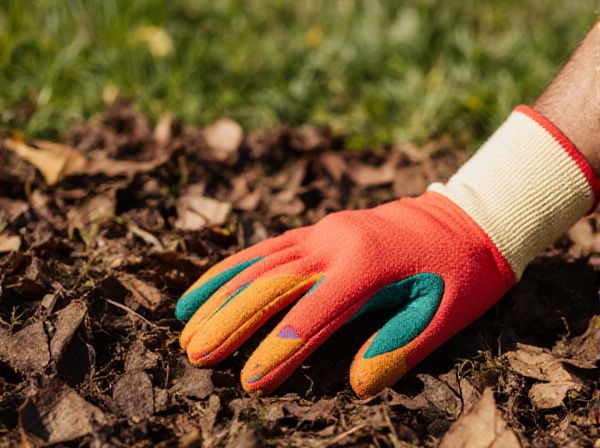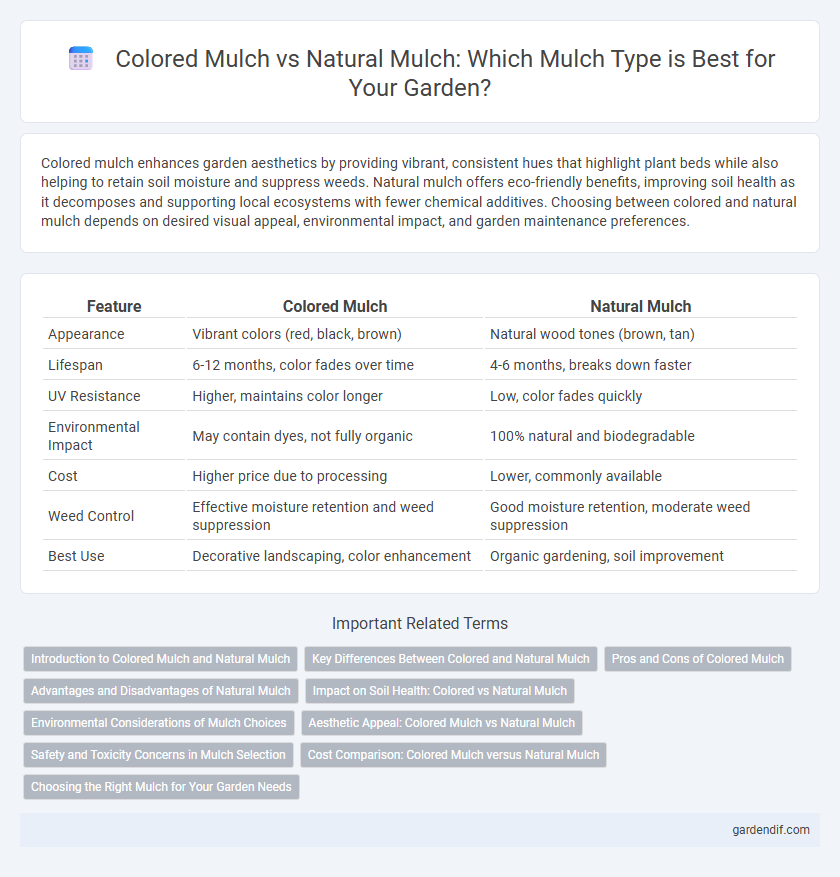
Colored mulch vs natural mulch Illustration
Colored mulch enhances garden aesthetics by providing vibrant, consistent hues that highlight plant beds while also helping to retain soil moisture and suppress weeds. Natural mulch offers eco-friendly benefits, improving soil health as it decomposes and supporting local ecosystems with fewer chemical additives. Choosing between colored and natural mulch depends on desired visual appeal, environmental impact, and garden maintenance preferences.
Table of Comparison
| Feature | Colored Mulch | Natural Mulch |
|---|---|---|
| Appearance | Vibrant colors (red, black, brown) | Natural wood tones (brown, tan) |
| Lifespan | 6-12 months, color fades over time | 4-6 months, breaks down faster |
| UV Resistance | Higher, maintains color longer | Low, color fades quickly |
| Environmental Impact | May contain dyes, not fully organic | 100% natural and biodegradable |
| Cost | Higher price due to processing | Lower, commonly available |
| Weed Control | Effective moisture retention and weed suppression | Good moisture retention, moderate weed suppression |
| Best Use | Decorative landscaping, color enhancement | Organic gardening, soil improvement |
Introduction to Colored Mulch and Natural Mulch
Colored mulch enhances landscaping aesthetics with vibrant pigments while offering the same moisture retention and soil protection benefits as natural mulch, which is derived from untreated organic materials like bark and wood chips. Natural mulch supports soil health by decomposing and enriching the soil with nutrients, whereas colored mulch provides a long-lasting decorative option with minimal nutrient contribution. Both types play crucial roles in weed suppression, temperature regulation, and erosion control in garden environments.
Key Differences Between Colored and Natural Mulch
Colored mulch contains dyes that enhance aesthetic appeal and offer longer-lasting vibrancy, while natural mulch decomposes more quickly and enriches soil nutrients over time. Natural mulch, often made from wood chips, bark, or leaves, provides better moisture retention and temperature regulation. Colored mulch, available in shades like red, black, and brown, primarily serves decorative purposes but may contain additives that impact decomposition rates and soil health.
Pros and Cons of Colored Mulch
Colored mulch offers enhanced visual appeal by providing vibrant shades that can complement landscape designs and help define planting areas, while natural mulch blends seamlessly with the environment and supports soil health through organic decomposition. Pros of colored mulch include long-lasting color that does not fade quickly, weed suppression, and moisture retention; cons involve potential chemical treatments that may affect soil quality, the possibility of dye washing out with heavy rain, and less organic matter contribution compared to natural mulch. Choosing colored mulch requires balancing aesthetics with environmental impact and soil sustainability for optimal garden health.
Advantages and Disadvantages of Natural Mulch
Natural mulch offers advantages such as improved soil fertility and moisture retention by decomposing and enriching the soil with organic matter. It enhances soil microbial activity and supports plant health, but disadvantages include faster decomposition requiring frequent replenishment and potential weed seed introduction. Unlike colored mulch, natural mulch provides a more sustainable, eco-friendly option that better supports long-term soil and plant vitality.
Impact on Soil Health: Colored vs Natural Mulch
Natural mulch improves soil health by enhancing microbial activity and increasing organic matter as it decomposes, leading to better nutrient cycling and moisture retention. Colored mulch, often made from dyed wood chips, may contain chemicals that can inhibit soil microorganisms and slow down organic matter integration. Choosing natural mulch supports a healthier soil ecosystem by promoting biodiversity and long-term fertility.
Environmental Considerations of Mulch Choices
Colored mulch often contains additives or dyes that may introduce chemicals into soil, potentially impacting beneficial microbial activity and plant health. Natural mulch, derived from untreated organic materials like wood chips or bark, promotes soil fertility and moisture retention without releasing harmful substances. Selecting mulch with minimal chemical content supports sustainable gardening practices and reduces environmental pollution risks.
Aesthetic Appeal: Colored Mulch vs Natural Mulch
Colored mulch enhances landscape design by providing vibrant, consistent hues that highlight garden features and complement plant colors, creating a visually striking environment. Natural mulch offers a more organic, earthy appearance that blends seamlessly with the surroundings, promoting a subtle and authentic aesthetic. Both types improve soil moisture retention and weed suppression, but colored mulch stands out for its ability to elevate curb appeal through bold visual contrast.
Safety and Toxicity Concerns in Mulch Selection
Colored mulch often contains synthetic dyes that may leach harmful chemicals into the soil, raising safety and toxicity concerns for children, pets, and plants. Natural mulch, derived from untreated organic materials such as wood chips or bark, poses fewer risks and promotes a healthier ecosystem by supporting soil microbes and reducing chemical exposure. Choosing mulch free from contaminants and certified as safe ensures a non-toxic environment for landscaping and gardening.
Cost Comparison: Colored Mulch versus Natural Mulch
Colored mulch typically costs 10% to 30% more than natural mulch due to the added expenses of pigments and processing. Natural mulch, sourced from shredded bark or wood chips, remains a more budget-friendly option while effectively retaining soil moisture and suppressing weeds. Homeowners seeking vibrant landscaping often weigh the higher initial investment of colored mulch against the longevity and eco-friendliness of natural mulch.
Choosing the Right Mulch for Your Garden Needs
Colored mulch enhances garden aesthetics by providing vibrant hues that complement landscape design, while natural mulch offers organic nutrients and better soil moisture retention. Selecting the right mulch depends on factors like plant type, soil health, desired visual appeal, and long-term garden maintenance requirements. Consider the chemical composition and durability of colored mulch versus the eco-friendly and biodegradable qualities of natural mulch to achieve optimal garden growth and appearance.
Colored mulch vs natural mulch Infographic

 gardendif.com
gardendif.com